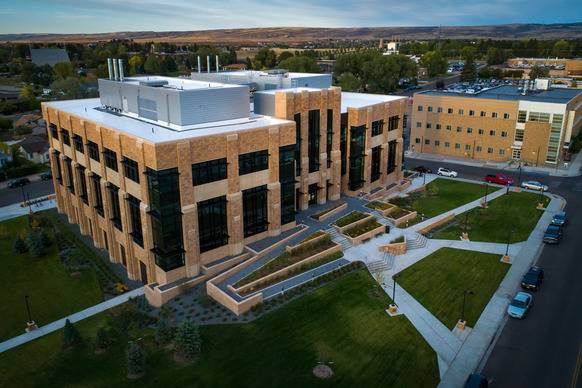EECS Announcements & Events
EECS Colloquia Series
 |
|
The Department of Electrical Engineering and Computer Science at the University of Wyoming is offering the EECS Colloquium series as a service to all who are interested in Electrical Engineering and Computer Science. Most seminars in Fall 2024 are scheduled for Monday 3:10PM -- 4:00PM in EERB 251. For help finding the locations of our seminar meetings, consult the on-line UWyo campus map.
|
|
CEPS Food Drive
When? Anytime
Where? The Main Office of Any CEPS Department
This Food Drive will not only help stock our Free Pantry but also allow us to come together as a community to make a positive impact on the lives of those facing food insecurity. Every donation of food can make a difference.
Here's How You Can Help:
- Drop off donations in the main office of any CEPS department.
- Donate non-perishable food items in jars, cans, or sealed packets.
- Suggested donations include:
- Sauces
- Soups
- Beans
- Canned or jarred vegetables
- Peanut butter
- Healthy snacks
- Dry cereal
Food Pantry Location and other resources
ESP4T and The Samsung Solve for Tomorrow Contest:
Teachers Desiree Riley and Christy Rodgers of CY Middle School in Casper, WY have been dedicated participants in the ESP4T program for several years. Desiree teaches an elective course based on the program, Destination Imagination, while Christy leads an Engineering Elective class. The knowledge, support, and inspiration they have gained from ESP4T have fueled their passion for innovation, ultimately leading them to compete in the Samsung Solve for Tomorrow contest.
Christy has entered the Solve for Tomorrow contest for six years, achieving remarkable success. She has been a state winner three times, and last year, she and her students were selected as a Top 10 National Finalist. At the national level, they presented their project and won the prestigious Samsung Employee Choice Award. Some of her previous projects include an Arduino-powered frost protection device for gardens and kinetic floor tiles that generate energy to charge cell phones also using Arduino.
Inspired by Christy’s achievements, Desiree entered the contest this year—and her idea was selected as a state winner, and then a top 10 finalist advancing to the National Finals in Washington, D.C., on April 28th. The concept involved an Arduino-based obstacle-avoidance vehicle that roams the school, displaying an interactive screen where students can engage with uplifting content throughout the day. Desiree’s students collaborated with Christy’s engineering students to bring this vision to life, creating SEL-BOT, the Social Emotional Support Robot.
So far, this invention has earned the school $50,000 in Samsung technology and classroom resources. If they win in Washington, D.C., the total prize will increase to $100,000 for their school.
This opportunity has provided the financial support to purchase critical resources to enhance the electrical engineering, computer science and creative problem solving programs at CY Middle School. More importantly, it has given both teachers and students hands-on experience in real-world applications of technology skills learned through ESP4T, preparing them for future innovation and problem-solving.
Quote from Desiree Riley:
"Had it not been for my experience with ESP4T, I never would have developed the knowledge,
skills, or confidence to enter a competition like this. This program has been transformative
to my teaching and has equipped me with invaluable tools that I apply not only in
my classroom but also in my personal life.
Remarks from a ESP4T Participant:
"As I was gathering this information to help promote your program, I realized that I had another great example of how the technology and skills that teachers gain in the ESP4T program extend beyond applications in science, engineering and robotics, they can also be integrated into thhe arts!
When I first took the ESP4T class, I was managing a high school Destination Imagination team for my daughter and her friends. When I introduced them to the capabilities of Arduino, they decided to incorporate it into their project, creating a meter that counted movements and a spiral light effect background. Thanks to the skills I had learned in ESP4T, I was able to guide them through the process. My daughter took the lead on building and programming the Arduino circuits, and while she was successful, the troubleshooting was so challenging that she swore she would never use Arduino again.
Fast forward to today, she's now a senior at UW in the Visual Communication Design Program, working on her BFA Capstone project. And guess what has she chosen to use as one of her medium? Arduino! This time, she’s incorporating it into a multimedia art installation that creates motion effects with light and shadow. Her work is currently on display in the Visual Arts Building gallery.
I just wanted to share this as a testament to how versatile and far-reaching the ESP4T learning experience can be. It’s amazing to see how these skills can apply to so many fields, even in ways we never expected!"
Learn more about the ESP4T Program here!
Robin Hill has been invited by Henri Stephanou of the Institut des sciences juridique et philosophique de la Sorbonne, co-editor of the forthcoming Oxford Handbook of Philosophy of Computer Science, to serve as lead author for a chapter on informal definitions of an algorithm. It will be part of a section on the concept of algorithm, which will be also approached, in other chapters, formally and through the complexity lens.

